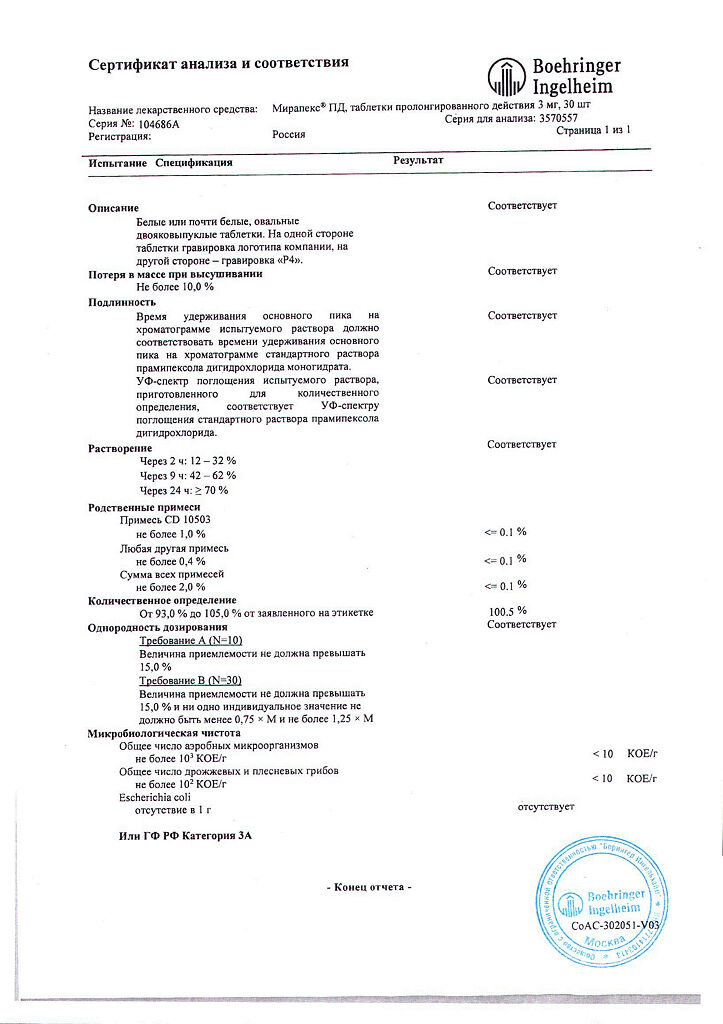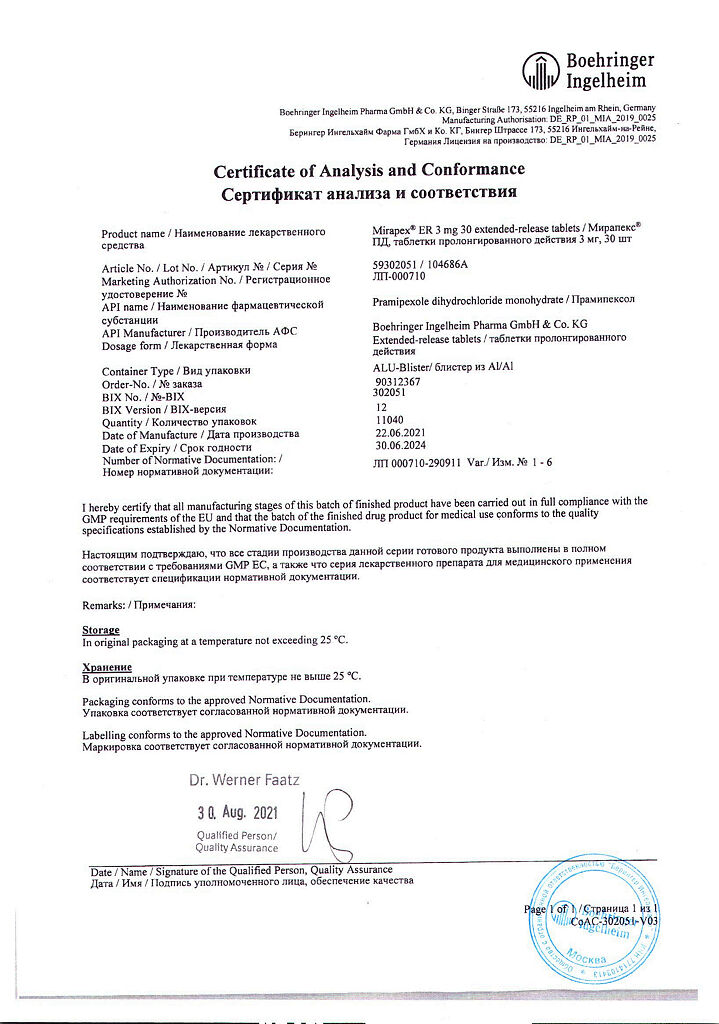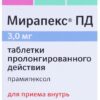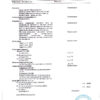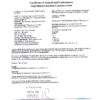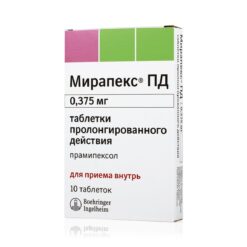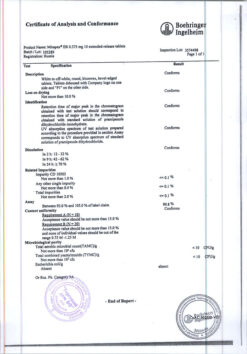No products in the cart.
Mirapex PD, 3 mg 30 pcs
€77.06 €64.22
Description
Mirapex PD is an antiparkinsonian drug – dopamine receptor agonist. With high selectivity and specificity it binds to dopamine receptors of subgroup D2, of which it has the most pronounced affinity for D3 receptors.
It reduces motor deficits in Parkinson’s disease by stimulating dopamine receptors in the striatum. Pramipexole inhibits the synthesis, release and metabolism of dopamine. In vitro, pramipexole protects dopamine neurons from degeneration occurring in response to ischemia or methamphetamine neurotoxicity.
Pramipexole in vitro protects neurons from levodopa neurotoxicity.
Decreases prolactin secretion (dose-dependent).
In clinical studies in healthy volunteers in whom the dose of Mirapex PD was increased faster than necessary (every 3 days) up to 4.5 mg/day, an increase in BP and HR was observed. This effect was not observed in patient studies.
Pharmacokinetics
Intake and distribution
Pramipexole is quickly and completely absorbed after oral administration. Absolute bioavailability is greater than 90% and Cmax in plasma is reached after approximately 6 h. As a rule, food intake does not affect the bioavailability of pramipexole.
A slight increase, approximately 20%, in Cmax and a delay, approximately 2 h, in time to reach Cmax after a fatty meal are not clinically significant.
Pramipexole exhibits linear kinetics and relatively little variability in plasma levels between patients, regardless of pharmaceutical form. Pramipexole binds very little to plasma proteins.
Metabolism and excretion
It is metabolized to a negligible degree.
About 90% of the dose is excreted through the kidneys (80% unchanged) and less than 2% is found in the feces. Total clearance of pramipexole is about 500 ml/min, renal clearance is about 400 ml/min. T1/2 fluctuates from 8 h in young adults to 12 h in the elderly.
Indications
Indications
Parkinson’s disease.
Pharmacological effect
Pharmacological effect
Mirapex PD is an antiparkinsonian drug – a dopamine receptor agonist. It binds with high selectivity and specificity to dopamine receptors of the D2 subgroup, of which it has the most pronounced affinity for D3 receptors.
Reduces motor activity deficits in Parkinson’s disease by stimulating dopamine receptors in the striatum. Pramipexole inhibits the synthesis, release and metabolism of dopamine. Pramipexole in vitro protects dopamine neurons from degeneration that occurs in response to ischemia or methamphetamine neurotoxicity.
Pramipexole protects neurons from levodopa neurotoxicity in vitro.
Reduces the secretion of prolactin (dose-dependent).
In clinical studies on healthy volunteers, in whom the dose of Mirapex PD was increased faster than it should (every 3 days), up to 4.5 mg/day, an increase in blood pressure and heart rate was observed. This effect was not observed in patient studies.
Pharmacokinetics
Suction and distribution
Pramipexole is rapidly and completely absorbed after oral administration. Absolute bioavailability exceeds more than 90% and Cmax in plasma is reached after approximately 6 hours. As a rule, food intake does not affect the bioavailability of pramipexole.
After ingestion of a fatty meal, there is a slight increase, approximately 20%, in Cmax and a slowdown, approximately 2 hours, in the time to reach Cmax, which has no clinical significance.
Pramipexole exhibits linear kinetics and relatively little variability in plasma levels between patients, regardless of pharmaceutical form. Pramipexole binds to plasma proteins to a very small extent.
Metabolism and excretion
Metabolized to a small extent.
About 90% of the dose is excreted through the kidneys (80% unchanged) and less than 2% is found in the feces. The total clearance of pramipexole is about 500 ml/min, the renal clearance is about 400 ml/min. T1/2 ranges from 8 hours in young people to 12 hours in older people.
Special instructions
Special instructions
During treatment with pramipexole, episodes of sudden falling asleep during daytime wakefulness were observed. Drowsiness usually develops when using Mirapex in doses greater than 1.5 mg/day. Episodes of sudden falling asleep against the background of daytime wakefulness occur against the background of already developed drowsiness.
Factors that increase the risk of developing drowsiness include: concomitant use of sedatives, sleep disorders, concomitant use of drugs that increase the level of pramipexole in the blood plasma (for example, cimetidine). Before prescribing Mirapex, the doctor must determine the presence of these risk factors. During therapy, it is necessary to monitor the patient’s condition to identify a tendency to drowsiness.
If severe daytime sleepiness develops or episodes of sudden falling asleep during daytime wakefulness occur that require active intervention, Mirapex should be discontinued. If it is necessary to continue therapy, the dose of the drug should be reduced and the patient should be advised to refrain from driving and other potentially hazardous activities.
During therapy with Mirapex, the incidence of arterial hypotension, as a rule, did not increase compared with placebo.
Elderly patients (65 years and older) require dose adjustment of Mirapex.
Since pramipexole is eliminated by the kidneys, dosage adjustments may be required in patients with kidney disease.
Impact on the ability to drive vehicles and operate machinery
The patient should refrain from driving and other potentially hazardous activities until the nature of the drug’s effect on the ability to concentrate and the speed of psychomotor reactions has been established.
Use in pediatrics
The safety and effectiveness of Mirapex in children has not been established.
Active ingredient
Active ingredient
Pramipexole
Composition
Composition
Active ingredient:
pramipexole dihydrochloride monohydrate 3 mg;
Excipients:
hypromellose 2208,
corn starch,
carbomer 941,
colloidal silicon dioxide,
magnesium stearate.
Pregnancy
Pregnancy
Possibly if the expected effect of therapy outweighs the potential risk to the fetus (adequate and well-controlled studies on use during pregnancy have not been conducted).
FDA category of effect on the fetus is C.
During treatment, breastfeeding should be stopped (there are no data on penetration into breast milk in humans).
Contraindications
Contraindications
Hypersensitivity
Side Effects
Side Effects
From the nervous system and sensory organs: asthenia, drowsiness/insomnia, hallucinations, delirium, amnesia, confusion, dizziness, anxiety, depression, dysphagia, dystonia, akathisia, thinking disorders, suicidal ideation, extrapyramidal syndrome, dyskinesia, tremor, hyposthesia, hypokinesia, myoclonus, ataxia, impaired coordination of movements, diplopia, paralysis of accommodation, conjunctivitis, hearing loss; in isolated cases (with a rapid dose reduction or abrupt withdrawal) – neuroleptic malignant syndrome (hyperthermia, muscle rigidity, impaired consciousness, autonomic lability).
From the cardiovascular system and blood (hematopoiesis, hemostasis): orthostatic hypotension, tachycardia, arrhythmia.
From the respiratory system: shortness of breath, rhinitis, pharyngitis, sinusitis, flu-like syndrome, increased cough.
From the gastrointestinal tract: nausea, vomiting, dyspepsia, flatulence, diarrhea, dry mouth, anorexia, constipation.
From the musculoskeletal system: muscle hypertonicity, leg muscle cramps, muscle twitching, myasthenia gravis, arthritis, bursitis.
Other: fever; peripheral edema, sweating, increased intraocular pressure, decreased libido, impotence, weight loss; increased urination, urinary tract infections; pain syndrome, incl. chest pain, abdominal pain, pain in the lumbosacral spine, neck pain; voice change; increased CPK activity; allergic reactions.
Interaction
Interaction
Pramipexole to a minor extent
Drugs that inhibit active renal tubular secretion of cationic drugs (eg, cimetidine), or which are themselves eliminated by active renal tubular secretion, may interact with pramipexole resulting in decreased clearance of one or both drugs.
In case of simultaneous use of such drugs (including amantadine) and pramipexole, it is necessary to pay attention to signs of excessive dopamine stimulation such as dyskinesia, agitation or hallucinations. In such cases, it is necessary to reduce the dose.
Selegiline and levodopa do not affect the pharmacokinetics of pramipexole. Pramipexole does not affect the overall absorption or elimination of levodopa. Interactions with anticholinergic drugs and amantadine have not been studied.
However, interaction with amantadine is possible, because drugs have a similar mechanism of elimination. Anticholinergic drugs are primarily eliminated metabolically, so interactions with pramipexole are unlikely.
When increasing the dose of the drug in patients with Parkinson’s disease, it is recommended to reduce the dose of levodopa, while the dose of other antiparkinsonian drugs must be maintained at a constant level.
Due to possible cumulative effects, patients should be advised to exercise caution when taking other sedative drugs or alcohol in combination with Mirapex PD, as well as when taking drugs that increase the plasma concentration of pramipexole (for example, cimetidine).
Overdose
Overdose
Symptoms: not established. There is no clinical experience with a significant overdose of Mirapex. One patient with a 10-year history of schizophrenia took 11 mg/day of pramipexole for 2 days; this is 2-3 times more than the daily dose recommended by the protocol.
No undesirable effects were noted due to the dose increase. Blood pressure remained stable, although heart rate increased to 100-120 beats/min.
Treatment: There is no known antidote for pramipexole.
When symptoms of central nervous system stimulation appear, antipsychotics – derivatives of phenothiazine or butyrophenone – can be used, but the effectiveness of these drugs in eliminating the effects of an overdose of Mirapex has not been assessed.
When treating an overdose, maintenance therapy, gastric lavage, the use of agents for rehydration and detoxification of the body, and ECG monitoring may be required.
Storage conditions
Storage conditions
In a dry place, at a temperature not exceeding 25 °C
Shelf life
Shelf life
2 years
Manufacturer
Manufacturer
Boehringer Ingelheim Pharma GmbH & Co.KG, Germany
Additional information
| Shelf life | 2 years |
|---|---|
| Conditions of storage | In a dry place, at a temperature not exceeding 25 °C |
| Manufacturer | Boehringer Ingelheim Pharma GmbH & Co. |
| Medication form | sustained release tablets |
| Brand | #Н/Д |
Other forms…
Related products
Buy Mirapex PD, 3 mg 30 pcs with delivery to USA, UK, Europe and over 120 other countries.


